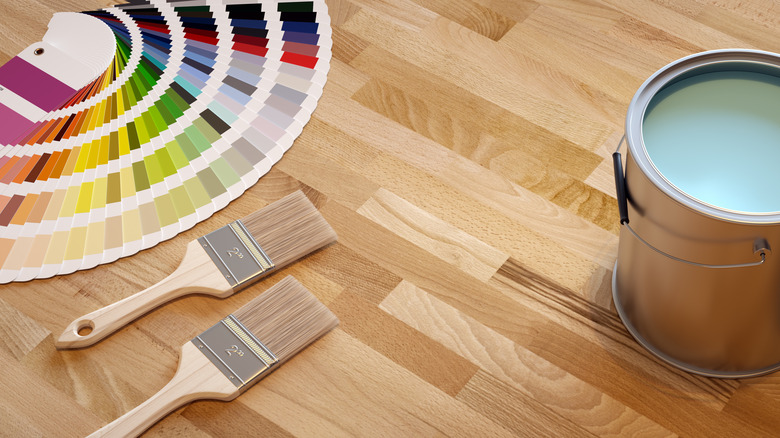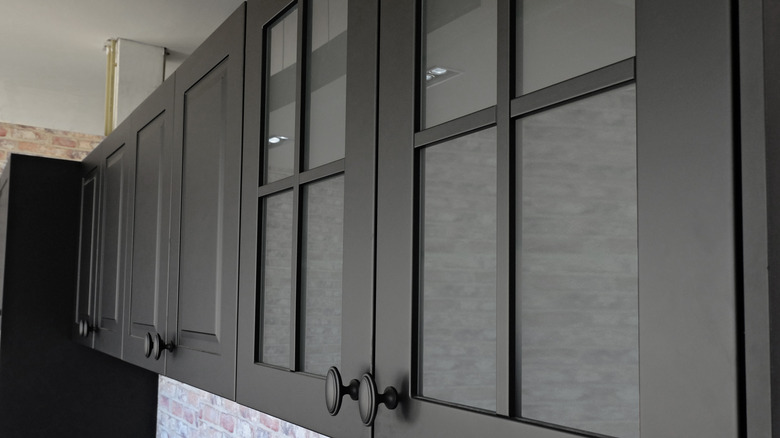Don't Make These Common Mistakes At The Paint Store
When it comes to updating or renovating a home, painting the walls is one of the biggest tasks. Changing the color of a room makes a huge difference in the aesthetic, and picking the right color is important. These days, there are so many different options to choose from, and each offers a variety of benefits. Paint is no longer just about color — it also comes down to factors like finish, texture, and even the formula itself.
According to Angi, having all the facts and specifics worked out before purchasing a paint will help make the job ahead less stressful, and ensure you are happy with the end result. Many homeowners or renters can fall into these common mistakes when it comes to picking out paint, but the following tips will help you avoid disaster. Updating your home should feel exciting and rewarding, not daunting or overwhelming. Knowing what to look for when you head to the paint section will give you the confidence to pick out the perfect tone, finish, and formula.
Don't under prepare
One of the most common issues people run into when painting their home is not buying enough paint. According to Lowes, one gallon of paint can cover between 350 and 400 square feet. To make sure you have enough, measure the area you plan to coat before purchasing anything. This will allow you to calculate how many gallons of paint you'll need. There is nothing more frustrating than having to go back to the store for more supplies in the middle of a job.
Even if you buy too much, you are better off with an overage of paint than too little. You can always use the leftover to touch up spots that are in need of a little TLC or use it for smaller areas and detail. The internet offers free paint calculators that help you determine exactly how much to buy, so you'll have a number and amount in mind before even leaving your home. Don't leave it up to chance: check before you buy to save time and stress.
Never bypass swatch tests
You might go to the store and think you've found the perfect shade of paint, only to get home, apply it, but find it looks all wrong. Using swatches to determine if a shade will match your home and walls is an important step to take before coating an entire room. Family Handy Man says the best way to know if a color is going to work is by painting a strip right onto the wall in question. Take the time to apply one or two coats, then try other swatches a few inches apart if you are considering more than one tone.
Make sure to keep two to three inches between each different swatch, in order to get a better idea of how a color will look on its own. Give the paint time to dry, then take a few hours or even days to sit with the options. Samples can look different in-store, especially when it comes to swatches. The existing hue of your wall also changes how a color may turn out, so it is best to test your selections before committing to them.
Do not forget the finish
Paint comes in a variety of different finishes, or "sheen." This determines the way it looks on a surface once it is dry. Some options look matte or flat, while others have a shine or gloss, but it all comes down to which you prefer. Most paint samples come in a semi-gloss finish, so you'll have to request any other sheens you're interested in. When testing swatches, notice how the finish looks on your wall. Do you prefer a slight gloss, or does the flat appearance suit the mood of the space. High-gloss paint is commonly used for trim, as it is easier to clean and lower maintenance — ideal for high-traffic areas.
In addition to aesthetics, you should consider practical factors. If you have children or pets, scuffs and marks can appear throughout your home. The Savvy Heart notes that semi-gloss and high-gloss options are easier to wipe down, which saves time when it comes to cleaning your walls. Matte paints look great in rooms with darker colors since they don't reflect light, creating a more intense effect. Always pay attention to the finish on a paint you select at the store because overlooking this can change the entire outcome of your space.
Don't ignore Your Current Aesthetic
If you are painting over an existing color, or even transforming a white wall, you'll want to keep the current decor of the room in mind. Maybe you designed the space to match white, beige, and taupe tones, but painting the walls blue or green could clash with the current furnishings. When shopping for a new shade, think about how it will complement what is already in your home. Do you plan to redecorate completely? If so, you can start over and choose any color then build outward from there. Painting Contractors Denver says if you plan to keep linens, furniture, photos, or other items that have a particular color scheme, choose new paint colors wisely.
Try applying swatches of your preferred colors in an area that already holds tables, beds, chairs, dining sets, etc. Use these as a contrast to decide if the new paint will match or clash. Swatches are easy to cover up, but think of them as a cheat sheet for finding the right color. It is easier to change paint hues than to replace a favorite couch. You can also bring in a photo of the room you plan to renovate and use it when perusing color options.
Avoid overlooking undertones
All paints have different undertones, varying from warm to cool. If you've ever compared different hues of white paint, you'll notice some look blue while others look yellow or extremely white. If you opt for a cool paint tone, expect to see greens, blues, and purples when applied to a wall. Warm undertones will make colors appear more yellow, pink, or beige. Either way, these subtle hues can completely transform a paint job. Whenever you're in the store, Arizona Painting Company recommends checking the darkest shade on any paint strip you're considering, because it gives you a better idea of what undertone to expect.
Depending on your decor and preferences, you'll want to decide if you're going for a warmer or cooler vibe in the room. Using a swatch is helpful to see how the paint will look on the wall, but paint strips can give you a good sense whenever you're shopping. Just make sure to pay attention when purchasing to what you grabbed, and defer to the boldest shade for undertone guidance.
Don't buy cheap brushes
A paintbrush makes all the difference, and picking the right one at the store is imperative to creating a solid finished product. According to Lowes, synthetic brushes are ideal for latex-based paints, so stick to bristles made of polyester or nylon. If your paint is oil-based, pick up a brush made with natural bristles. Don't skimp on purchasing the right tools, because they make as big of an impact on the results as the paint itself.
Spending more on your paint supplies from a reputable store will better ensure good results. Lowes even has a buying guide that helps you pick the right brush for your projects. Use the new brushes to paint swatches or a portion of your wall, then let it sit for a few days so you can see it in different lighting, weather conditions, and after it dries. All of these factors impact the finished product, so take your time when it comes to painting.






